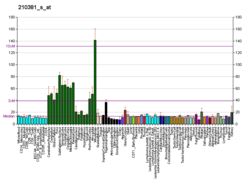Top Qs
Timeline
Chat
Perspective
Cholecystokinin B receptor
Protein-coding gene From Wikipedia, the free encyclopedia
Remove ads
The cholecystokinin B receptor also known as CCKBR or CCK2 is a protein[5] that in humans is encoded by the CCKBR gene.[6]
This gene encodes a G protein-coupled receptor for gastrin and cholecystokinin (CCK),[7][8][9] regulatory peptides of the brain and gastrointestinal tract. This protein is a type B gastrin receptor, which has a high affinity for both sulfated and nonsulfated CCK analogs and is found principally in the central nervous system and the gastrointestinal tract. A misspliced transcript variant including an intron has been observed in cells from colorectal and pancreatic tumors.[10]
Remove ads
CNS effects
Summarize
Perspective
CCK receptors significantly influence neurotransmission in the brain, regulating anxiety, feeding, and locomotion. CCK-B expression may correlate parallel to anxiety and depression phenotypes in humans. CCK-B receptors possess a complex regulation of dopamine activity in the brain. CCK-B activation appears to possess a general inhibitory action on dopamine activity in the brain, opposing the dopamine-enhancing effects of CCK-A. However, the effects of CCK-B on dopamine activity vary depending on location.[11] CCK-B antagonism enhances dopamine release in rat striatum.[12] Activation enhances GABA release in rat anterior nucleus accumbens.[13] CCK-B receptors modulate dopamine release, and influence the development of tolerance to opioids.[14] CCK-B activation decreases amphetamine-induced DA release, and contributes to individual variability in response to amphetamine.[15]
In rats, CCK-B antagonism prevents the stress-induced reactivation of cocaine-induced conditioned place preference, and prevents the long-term maintenance and reinstatement of morphine-induced CPP.[16] Blockade of CCK-B potentiates cocaine-induced dopamine overflow in rat striatum.[12] CCK-B may pose a modulatory role in Parkinson's disease. Blockade of CCK-B in dopamine-depleted squirrel monkeys induces significant enhancement of locomotor response to L-DOPA.[17] One study shows that visual hallucinations in Parkinson's disease are associated with cholecystokinin −45C>T polymorphism, and this association is still observed in the presence of the cholecystokinin-A receptor TC/CC genotype, indicating a possible interaction of these two genes in the visual hallucinogenesis in Parkinson's disease.[18]
Remove ads
Gastrointestinal tract
The cholecystokinin B receptor is stimulated by CCK and gastrin in the stomach during digestion.[19]
Selective ligands
The cholecystokinin B receptor responds to a number of ligands.
Agonists
- Cholecystokinin
- CCK-4
- Gastrin
- BBL-454
Antagonists
- Proglumide
- CI-988
- CI-1015
- L-365,260
- L-369,293
- YF476
- YM-022
- RP-69758
- LY-225,910
- LY-288,513
- PD-135,158
- PD-145,942
Inverse agonists
- L-740,093
See also
References
Further reading
External links
Wikiwand - on
Seamless Wikipedia browsing. On steroids.
Remove ads






